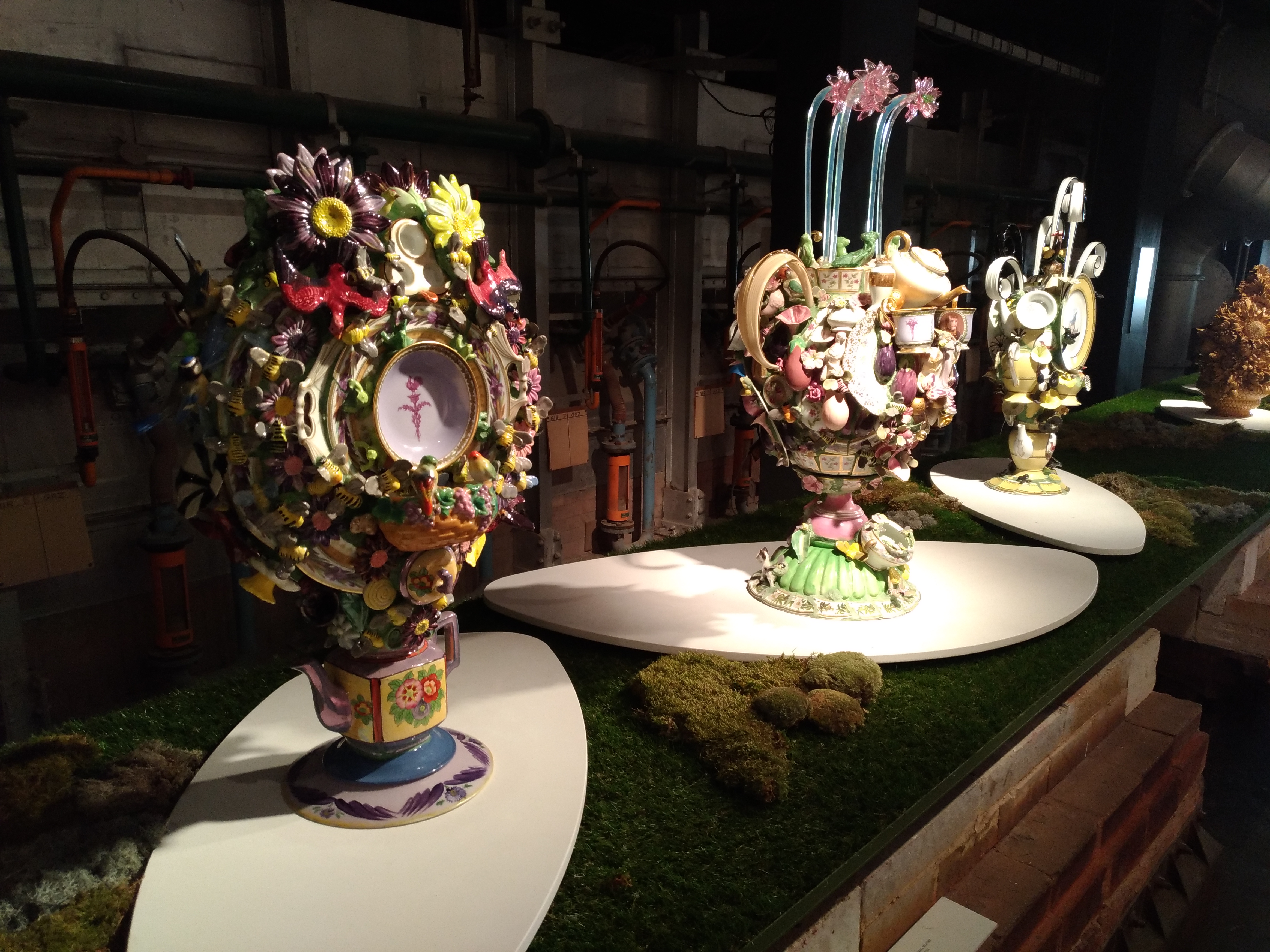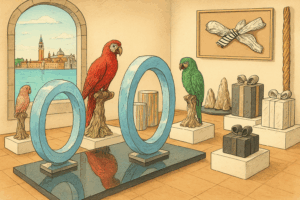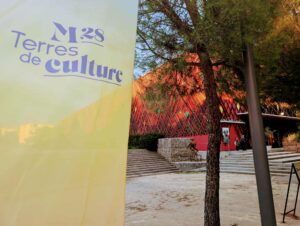Limoges, international capital of a certain craft industry

 In the center of France, easily reachable with the train from Paris, the city of Limoges is famous for his long story with local handicraft with noble materials, such as porcelain or leather.
In the center of France, easily reachable with the train from Paris, the city of Limoges is famous for his long story with local handicraft with noble materials, such as porcelain or leather.
This know-how is still on track to propose to the visitors how it appeared there, the processes of productions and eventually chances to make the acquisition back to your place.
Then, we’re sure that you would have a different opinion beyond this virtual visit, and learn more about the opportunities and methods, in order to experience new kinds of Art! By AP


Have a look on the Limoges City Hall, its fountain and its porcelain-based street furniture… On the right side, this former refrigerating plant, originally imagined by the architect Roger Gonthier. Restored after the idea of the municipality of Limoges in 1978, this building is now transformed into a local exhibition hall, known as the Pavillon du Verdurier. Full of Art-Déco mosaics, its basement stained glasses were designed by Francis Chigot, naturally installed after the exhibition dedicated to this glassmaker artist, back in 1980 (Photo credits: Alex Plato).


The historic center is filled with half-timbered houses, testimony to a strong architectural past! An example, the Saint-Etienne Cathedral is the main church in Limoges and the seat of the bishopric. Located in the heart of the old quarters of this porcelain city, this edifice adjoins the Evêché gardens and the Museum of Fine Arts, it is the only religious monument in Limousin to be built in a homogeneous Gothic style.


 Views of the legendary Limoges Bénedictins train station and the Limoges Botanical Garden where you could find those Terra Aventura stamped pins if you take up the challenge of this cultural trail game, whose application is available for download on your mobile phone. This treasure hunt offers many amazing route to discover throughout the region of New Aquitaine, naturally including this department of Haute-Vienne. An area rich in know-how, starring porcelain, tannery, leather, gloves, shoes (JM Weston) and even textile manufactures (Smuggler costumes).
Views of the legendary Limoges Bénedictins train station and the Limoges Botanical Garden where you could find those Terra Aventura stamped pins if you take up the challenge of this cultural trail game, whose application is available for download on your mobile phone. This treasure hunt offers many amazing route to discover throughout the region of New Aquitaine, naturally including this department of Haute-Vienne. An area rich in know-how, starring porcelain, tannery, leather, gloves, shoes (JM Weston) and even textile manufactures (Smuggler costumes).
The Bernardaud Porcelain Manufactory adapts to the fashions
The museum of the historical Bernardaud porcelain factory (created in 1863), located in the heart of Limoges since 1998, presents the art of approaching porcelain from the mineral stage to the artistic stage. In addition, the Maison Bernardaud obtained the Foundation label in 2002 allowing the holding of international temporary exhibitions held every summer.

Thus an inner visiting circuit is installed in some of the old workshops and presents the different stages of porcelain manufacture, as well as a demonstration of manufacturing and decorative techniques that would guide you an through this interactive tour.
The better the quality of kaolin is, the better the porcelain would be… Indeed since it was discovered by Marco Polo in the 13th century, it was only adopted by Europeans in the 18th, and it took much time to master the different inherent techniques.
A development facilitated in the region of Limoges by the proximity of sources of kaolin (now replaced by more premium German and New Zealand kaolin) and waterlogged forests.
 The porcelain will result from a mix of different raw materials, going through several liquid stages (slip) then solid, all worked using plaster molds, reusable up to 40 times.
The porcelain will result from a mix of different raw materials, going through several liquid stages (slip) then solid, all worked using plaster molds, reusable up to 40 times.
A demonstration is thus proposed during the visit of this Bernardaud factory in particular through different machines including the calibration machine to refine the more complex forms or the sufficiently large isostatic press (10 tons) to bind the set of components and more suitable for dishes (up to 400 per hour).
 A process that does not stop there since follow the so-called sharp cooking (24 hours at 900 °) which precedes the enameling in a bath of email to reveal all the properties of each mineral and finally an ultimate 1200 ° large fire cooking. This step will decide the fate of each porcelain as to its quality which will be the object of a choice.
A process that does not stop there since follow the so-called sharp cooking (24 hours at 900 °) which precedes the enameling in a bath of email to reveal all the properties of each mineral and finally an ultimate 1200 ° large fire cooking. This step will decide the fate of each porcelain as to its quality which will be the object of a choice.
Moreover and naturally in this case, quality control is essential, since there is an average of 25% bad waste, some of which can be used for other artistic creations or road surface to reflect the light (cf project Lumiroute Limoges).
The most noble phase of decoration can be in the form of screen printing or have the privilege of manual work of extreme care and whose price could be invaluable.


A set of different collaborations of the Bernardaud house with great designers, stored in those old carts for ovens, then personalized dishes addressed to large restaurants.








A temporary exhibition entitled C’est le bouquet!, that took place in the early months of 2018, within the walls of the Fondation Bernardaud, proposes a mix of artists of multiple nationalities mixing their respective worlds like the American artists Christopher Adams and his succulent plants, Joan Bankemper and his still lifes in relief, the Australian Alice Couttoupes and her work on plant species present in Australia before the arrival of the settlers, the smeared white mussels of the Japanese Hitomi Hosono, the country offerings in brown tones by Christopher Russell, the water lilies by Malene Hartmann Rasmussen or the porcelain anemones by Zemer Peled.
The Adrien Dubouché National Museum dedicated to the Arts of Ceramics and Porcelain


A museum created in 1845 that moved to its current location in 1860.
Thus, Adrien Dubouché bequeathed his collection accumulated over the years and the French government eventually nationalized it to make it a museum, which is since 1881, part of the 37 national museums and where is located behind an art school.


Since 2012, this huge bucolic space has been transformed around four areas including a ceramics manufacturing technique, a world tour of ceramics from around the world and its various uses including medical (with recent medical achievements by local companies on ceramic prostheses), space rocket heads also made of ceramic, all accompanied by a signage made entirely of ceramic.



 Once there, you would be immersed in a consequent reserve of 18,000 artworks, among them, only 5,000 are exhibited and 1,800 visible in the great retrospective hall, dedicated to ceramics from all over the world, from the Merigous door handle, from Limoges porcelain, to British or German pottery.
Once there, you would be immersed in a consequent reserve of 18,000 artworks, among them, only 5,000 are exhibited and 1,800 visible in the great retrospective hall, dedicated to ceramics from all over the world, from the Merigous door handle, from Limoges porcelain, to British or German pottery.
Furthermore, don’t miss the temple consecrated to 100% Limoges porcelain, thanks to a modern scenography, notably designed in 2012, by the scenographer Etienne Bardelli and the Atelier ter Bekke & Beha.
In this exhibition space, you would certainly admire the first Limoges porcelain pieces, dating from 1771, made by the time within a medallion shape.
 In the other hand, lots of other exceptional pieces are present including the first exclusive handmade realizations of the Manufacture Ruaud.
In the other hand, lots of other exceptional pieces are present including the first exclusive handmade realizations of the Manufacture Ruaud.
In the twentieth century, a new production method for ceramics also appeared to serve as an advertising message, where this industry tried to adapt to the demands of the market, quite changing from a year to another.
Those contemporary realizations illustrated through the design porcelain dolls, funerary plates and even the dishware for the former Concorde flights. Then the first design achievements arose with those very original half cups of the French sculptor Arman but also plenty of other innovations, made of ceramic dishes, able to fit in a washing machine and maybe adorning your walls meeting, in a sense, some new needs of your everyday life…
Musée National Adrien Dubouché / Adress : 8 Place Winston Churchill, 87000 Limoges (France) / Open everyday unless tuesday, from 10am to 12.30pm & 2pm to 5.30pm / Phone : 00 33 (0)5 55 33 08 50
The route of the porcelain allows the visit extends through the whole department of Haute-Vienne and allows the visit of many other sites related to this Art…


The Limoges Casseaux Oven Museum houses a huge round porcelain oven, classified as a Historic Monument, retraces the adventure of porcelain manufacturing under the fascinating angle of techniques and working memory.


In addition, an exhibition titled Constellations Porcelains, was held at the end of the year 2017, it was simultaneously on 4 sites and devoted to the history of Limoges porcelain, its uses and representations. Designed by Jean-Marc Ferrer, art historian, curator and editorial leader of the Ardents Editors, she is interested in the theme “Photography and porcelain: reflections of the banks of Vienna in Limoges in the nineteenth century”. Finally, in the immediate vicinity, Manufacture Royale de Limoges offers its exclusive creations such as this tableware, with the effigy of Fabergé.
Other ways to design enamels in and around Limoges
 Located on the boulevard Louis Blanc, boulevard des porcelainiers, the Comptoir des Savoir-Faire of the Christel Gallery, founded in 1957, specializes in handcrafted enamel creations, an art already used in the Middle Ages with crystal powder affixed to red copper, which has the ability to multi-cook at 900 °, on average ten to two for porcelain because the enamel is built in layers and thus proscribe the emanations of copper, calamine, which can emerge from copper when cooking.
Located on the boulevard Louis Blanc, boulevard des porcelainiers, the Comptoir des Savoir-Faire of the Christel Gallery, founded in 1957, specializes in handcrafted enamel creations, an art already used in the Middle Ages with crystal powder affixed to red copper, which has the ability to multi-cook at 900 °, on average ten to two for porcelain because the enamel is built in layers and thus proscribe the emanations of copper, calamine, which can emerge from copper when cooking.
However, due to European directives which have been hampering the lead composition for 5 years, the new enamel powder, nowadays manufactured in the only European factory, located in Condat sur Vienne. For instance, this new process complicates in a way, the work of those craftsmen since the lead allowed a much better adhesion.
 The enamelling techniques ancestral, known as the “Work of Limoges”, were partitioned and the field raised whose main sponsors were the clergy, this city being on the way to Saint Jacques de Compostela and more particularly the way of Vézelay. While some wealthy clergy endowed their religious objects with precious stones such as sapphire or ruby, enamel was a pretext for a cheaper color that allowed the Limoges Work to cross the ages and be present. currently in the whole world.
The enamelling techniques ancestral, known as the “Work of Limoges”, were partitioned and the field raised whose main sponsors were the clergy, this city being on the way to Saint Jacques de Compostela and more particularly the way of Vézelay. While some wealthy clergy endowed their religious objects with precious stones such as sapphire or ruby, enamel was a pretext for a cheaper color that allowed the Limoges Work to cross the ages and be present. currently in the whole world.
Unfortunately, the World War I decimated the craftsmen enamellers, a new generation of artisans called “awakeners” emerge precipitously to replace them so that they are aesthetically inspired by the School of Crozant for different reasons.

While the Fire Arts tend to be rather trivialized, the Bettencourt Foundation prize awarded to Pierre Christel in 2005 helped to improve this expertise.
From 27 October 2017, an exhibition of the designer Pierre Christel around a collection of twenty vases, unique pieces because unlike the porcelain technique, the enamel has no molds but is subject to significant costs in raw materials, like copper…
You may also notice the work of the dinandier who would subsequently hammer it, including consequent expenses for each piece produced (approximately between 600 and 1000 euros).


Moreover, housed on the same boulevard, the Bocal Gallery offers a rotating collection of other know-how of a collective of a dozen local artists, among other enamellers, plumassiers and porcelain creators.
Fashion in Saint-Junien is worn like a glove
The art of glove making came in the 11th century in the locality of Saint Junien, thanks to the local presence of water, skins and chestnut bark and beech for the maintenance of these skins favoring the tannery . There are still three manufacturers in this mythical city.
The traditional glove having lost its superb industrial, the manufacture Agnelle specializes now in luxury glove, especially for personalities whose pair attributed to the American First Lady Melania Trump, and designed for Ralph Lauren.


To make a glove, it requires 3 pieces: the central unit, the fork, the thumb that will go under a press.


Most will come from peccaris, horses and lambs and then other textures will come as decoration like crocodile, rabbits, chicken legs or even eels skins, the satin doubling inside all of these pairs of gloves, many of which come from the order of prestigious haute-couture brands, such as Dior, Givenchy or Azzedine Alaïa.


A set that can be completed by a very detailed tinting work on the color of the skin, according to the orders of these renowned customers who can then back their image such as these long gloves Dior and these mittens for Louis Vuitton.









1 thought on “Limoges, international capital of a certain craft industry”